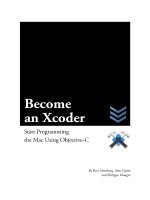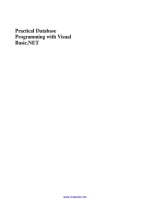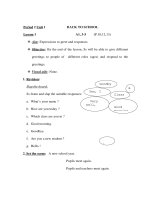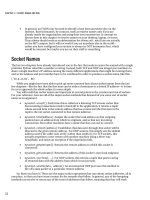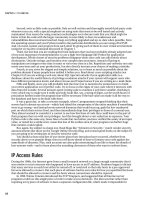Expert python programming become an ace python programmer by learning best coding practices and advance level concepts with python 3 5 2nd edition
Bạn đang xem bản rút gọn của tài liệu. Xem và tải ngay bản đầy đủ của tài liệu tại đây (3.98 MB, 536 trang )
Expert Python Programming
Second Edition
Become an ace Python programmer by learning best
coding practices and advance-level concepts with
Python 3.5
Michał Jaworski
Tarek Ziadé
BIRMINGHAM - MUMBAI
Expert Python Programming
Second Edition
Copyright © 2016 Packt Publishing
All rights reserved. No part of this book may be reproduced, stored in a retrieval
system, or transmitted in any form or by any means, without the prior written
permission of the publisher, except in the case of brief quotations embedded in
critical articles or reviews.
Every effort has been made in the preparation of this book to ensure the accuracy
of the information presented. However, the information contained in this book is
sold without warranty, either express or implied. Neither the authors, nor Packt
Publishing, and its dealers and distributors will be held liable for any damages
caused or alleged to be caused directly or indirectly by this book.
Packt Publishing has endeavored to provide trademark information about all of the
companies and products mentioned in this book by the appropriate use of capitals.
However, Packt Publishing cannot guarantee the accuracy of this information.
First published: September 2008
Second edition: May 2016
Production reference: 1160516
Published by Packt Publishing Ltd.
Livery Place
35 Livery Street
Birmingham B3 2PB, UK.
ISBN 978-1-78588-685-0
www.packtpub.com
Credits
Authors
Michał Jaworski
Proofreader
Safis Editing
Tarek Ziadé
Indexer
Reviewer
Rekha Nair
Facundo Batista
Graphics
Commissioning Editor
Jason Monteiro
Kunal Parikh
Production Coordinator
Acquisition Editor
Aparna Bhagat
Meeta Rajani
Cover Work
Technical Editor
Pankaj Kadam
Copy Editor
Laxmi Subramanian
Aparna Bhagat
About the Authors
Michał Jaworski has 7 years of experience in Python. He is also the creator of
graceful, which is a REST framework built on top of falcon. He has been in various
roles at different companies: from an ordinary full-stack developer through software
architect to VP of engineering in a fast-paced start-up company. He is currently a
lead backend engineer in TV Store team at Opera Software. He is highly experienced
in designing high-performance distributed services. He is also an active contributor
to some of the popular Python open source projects.
Tarek Ziadé is an engineering manager at Mozilla, working with a team
specialized in building web services in Python at scale for Firefox. He's contributed
to the Python packaging effort and has worked with a lot of different Python web
frameworks since Zope in the early days.
Tarek has also created Afpy, the French Python User Group, and has written two
books on Python in French. He has delivered numerous talks and tutorials in French
at international events such as Solutions Linux, PyCon, OSCON, and EuroPython.
About the Reviewer
Facundo Batista is a specialist in the Python programming language, with more
than 15 years of experience with it. He is a core developer of the language, and a
member by merit of the Python Software Foundation. He also received the 2009
Community Service Award for organizing PyCon Argentina and the Argentinian
Python community as well as contributions to the standard library and work in
translating the Python documentation.
He delivers talks in the main Python conferences in Argentina and other countries
(The United States and Europe). In general, he has strong distributed collaborative
experience from being involved in FLOSS development and working with people
around the globe for more than 10 years.
He worked as a telecommunication engineer at Telefónica Móviles and Ericsson, and
as a Python expert at Cyclelogic (developer in chief) and Canonical (senior software
developer, his current position).
He also loves playing tennis, and is a father of two wonderful children.
www.PacktPub.com
eBooks, discount offers, and more
Did you know that Packt offers eBook versions of every book published, with PDF
and ePub files available? You can upgrade to the eBook version at www.PacktPub.com
and as a print book customer, you are entitled to a discount on the eBook copy. Get in
touch with us at for more details.
At www.PacktPub.com, you can also read a collection of free technical articles, sign
up for a range of free newsletters and receive exclusive discounts and offers on
Packt books and eBooks.
TM
/>
Do you need instant solutions to your IT questions? PacktLib is Packt's online digital
book library. Here, you can search, access, and read Packt's entire library of books.
Why subscribe?
• Fully searchable across every book published by Packt
• Copy and paste, print, and bookmark content
• On demand and accessible via a web browser
Table of Contents
Preface
Chapter 1: Current Status of Python
Where are we now and where we are going?
Why and how does Python change?
Getting up to date with changes – PEP documents
Python 3 adoption at the time of writing this book
The main differences between Python 3 and Python 2
Why should I care?
The main syntax differences and common pitfalls
Syntax changes
Changes in the standard library
Changes in datatypes and collections
xi
1
2
2
3
4
5
5
5
6
7
8
The popular tools and techniques used for maintaining cross-version
compatibility8
Not only CPython
12
Why should I care?
13
Stackless Python
13
Jython
14
IronPython
14
PyPy15
Modern approaches to Python development
16
Application-level isolation of Python environments
17
Why isolation?
19
Popular solutions
21
virtualenv21
venv23
buildout
24
Which one to choose?
24
[i]
Table of Contents
System-level environment isolation
Virtual development environments using Vagrant
Containerization versus virtualization
Popular productivity tools
Custom Python shells – IPython, bpython, ptpython, and so on
25
26
27
28
29
Interactive debuggers
Useful resources
Summary
31
32
33
Setting up the PYTHONSTARTUP environment variable
30
IPython
30
bpython
30
ptpython31
Chapter 2: Syntax Best Practices – below the Class Level
Python's built-in types
Strings and bytes
Implementation details
String concatenation
35
36
36
38
39
Collections
Lists and tuples
Dictionaries
Sets
Beyond basic collections – the collections module
40
40
45
49
50
Advanced syntax
51
Iterators51
The yield statement
52
Decorators56
General syntax and possible implementations
Usage and useful examples
Context managers – the with statement
General syntax and possible implementations
57
61
68
69
Other syntax elements you may not know yet
The for … else … statement
Function annotations
72
73
73
Summary
75
The general syntax
The possible uses
Chapter 3: Syntax Best Practices – above the Class Level
Subclassing built-in types
Accessing methods from superclasses
Old-style classes and super in Python 2
Understanding Python's Method Resolution Order
[ ii ]
74
74
77
78
80
82
83
Table of Contents
super pitfalls
87
Mixing super and explicit class calls
Heterogeneous arguments
87
89
Best practices
90
Advanced attribute access patterns
91
Descriptors92
Real-life example – lazily evaluated attributes
95
Properties98
Slots
101
Metaprogramming
102
Decorators – a method of metaprogramming
103
Class decorators
103
Using the __new__() method to override instance creation process
105
Metaclasses
108
The general syntax
New Python 3 syntax for metaclasses
Metaclass usage
Metaclass pitfalls
109
112
115
115
Some tips on code generation
116
exec, eval, and compile
Abstract Syntax Tree
Projects using code generation patterns
117
118
120
Summary
Chapter 4: Choosing Good Names
123
125
PEP 8 and naming best practices
125
Why and when to follow PEP 8?
126
Beyond PEP 8 – team-specific style guidelines
126
Naming styles
127
Variables127
Constants128
Naming and usage
129
Public and private variables
130
Functions and methods
131
The private controversy
132
Special methods
134
Arguments
134
Properties
134
Classes135
Modules and packages
135
The naming guide
Using the has or is prefix for Boolean elements
Using plurals for variables that are collections
Using explicit names for dictionaries
[ iii ]
136
136
136
136
Table of Contents
Avoiding generic names
Avoiding existing names
Best practices for arguments
Building arguments by iterative design
Trust the arguments and your tests
Using *args and **kwargs magic arguments carefully
Class names
Module and package names
Useful tools
Pylint
pep8 and flake8
Summary
Chapter 5: Writing a Package
Creating a package
The confusing state of Python packaging tools
The current landscape of Python packaging thanks to PyPA
Tool recommendations
136
138
138
139
139
141
143
143
144
144
146
147
149
149
150
150
151
Project configuration
152
The custom setup command
Working with packages during development
161
161
setup.py152
setup.cfg153
MANIFEST.in
154
Most important metadata
154
Trove classifiers
155
Common patterns
156
setup.py install
Uninstalling packages
setup.py develop or pip -e
Namespace packages
Why is it useful?
PEP 420 – implicit namespace packages
Namespace packages in previous Python versions
Uploading a package
PyPI – Python Package Index
Uploading to PyPI – or other package index
.pypirc
162
162
162
163
163
166
167
168
169
169
170
Source packages versus built packages
171
Standalone executables
When are standalone executables useful?
174
175
sdist171
bdist and wheels
172
[ iv ]
Table of Contents
Popular tools
176
Security of Python code in executable packages
184
PyInstaller177
cx_Freeze
181
py2exe and py2app
183
Making decompilation harder
Summary
185
186
Chapter 6: Deploying Code
The Twelve-Factor App
Deployment automation using Fabric
Your own package index or index mirror
PyPI mirroring
Deployment using a package
Common conventions and practices
The filesystem hierarchy
Isolation
Using process supervision tools
Application code should be run in user space
Using reverse HTTP proxies
Reloading processes gracefully
Code instrumentation and monitoring
Logging errors – sentry/raven
Monitoring system and application metrics
Dealing with application logs
Basic low-level log practices
Tools for log processing
Summary
Chapter 7: Python Extensions in Other Languages
Different language means – C or C++
How do extensions in C or C++ work
Why you might want to use extensions
Improving performance in critical code sections
Integrating existing code written in different languages
Integrating third-party dynamic libraries
Creating custom datatypes
Writing extensions
Pure C extensions
A closer look at Python/C API
Calling and binding conventions
Exception handling
Releasing GIL
Reference counting
[v]
187
188
189
195
196
197
207
207
207
208
210
210
211
212
213
215
218
218
220
223
225
226
226
228
228
229
230
230
230
231
235
240
242
244
246
Table of Contents
Cython
248
Cython as a source to source compiler
Cython as a language
248
250
Challenges
253
Additional complexity
253
Debugging
254
Interfacing with dynamic libraries without extensions
255
ctypes255
Loading libraries
Calling C functions using ctypes
Passing Python functions as C callbacks
255
257
258
CFFI262
Summary
263
Chapter 8: Managing Code
265
Version control systems
Centralized systems
Distributed systems
265
266
268
Distributed strategies
Centralized or distributed?
Use Git if you can
Git flow and GitHub flow
Continuous development processes
Continuous integration
Testing every commit
Merge testing through CI
Matrix testing
270
271
271
272
276
277
278
279
280
Continuous delivery
Continuous deployment
Popular tools for continuous integration
280
281
282
Choosing the right tool and common pitfalls
290
Jenkins
282
Buildbot286
Travis CI
288
GitLab CI
290
Problem 1 – too complex build strategies
Problem 2 – too long building time
Problem 3 – external job definitions
Problem 4 – lack of isolation
Summary
Chapter 9: Documenting Your Project
The seven rules of technical writing
Write in two steps
Target the readership
[ vi ]
291
291
292
293
294
295
295
296
297
Table of Contents
Use a simple style
Limit the scope of information
Use realistic code examples
Use a light but sufficient approach
Use templates
A reStructuredText primer
Section structure
Lists
Inline markup
Literal block
Links
Building the documentation
Building the portfolio
298
299
299
300
301
301
303
305
306
306
307
308
308
Making your own portfolio
Building the landscape
315
316
Documentation building and continuous integration
Summary
322
323
Design
309
Usage
310
Operations315
Producer's layout
Consumer's layout
Chapter 10: Test-Driven Development
I don't test
Test-driven development principles
Preventing software regression
Improving code quality
Providing the best developer documentation
Producing robust code faster
317
318
325
325
326
328
329
329
330
What kind of tests?
330
Python standard test tools
333
Acceptance tests
Unit tests
Functional tests
Integration tests
Load and performance testing
Code quality testing
330
331
331
332
332
333
unittest333
doctest337
I do test
unittest pitfalls
unittest alternatives
339
339
340
nose
py.test
340
344
[ vii ]
Table of Contents
Testing coverage
Fakes and mocks
348
351
Testing environment and dependency compatibility
358
Document-driven development
362
Building a fake
Using mocks
Dependency matrix testing
Writing a story
351
356
358
362
Summary
Chapter 11: Optimization – General Principles and Profiling
Techniques
The three rules of optimization
Make it work first
Work from the user's point of view
Keep the code readable and maintainable
Optimization strategy
Find another culprit
Scale the hardware
Writing a speed test
Finding bottlenecks
Profiling CPU usage
Macro-profiling
Micro-profiling
Measuring Pystones
364
365
365
366
367
367
368
368
368
369
370
370
371
375
378
Profiling memory usage
379
Profiling network usage
Summary
391
392
How Python deals with memory
Profiling memory
C code memory leaks
379
382
390
Chapter 12: Optimization – Some Powerful Techniques
Reducing the complexity
Cyclomatic complexity
The big O notation
Simplifying
Searching in a list
Using a set instead of a list
393
394
396
396
399
399
400
Using collections
deque
defaultdict
namedtuple
401
401
403
404
[ viii ]
Table of Contents
Using architectural trade-offs
Using heuristics and approximation algorithms
Using task queues and delayed processing
Using probabilistic data structures
Caching
Deterministic caching
Nondeterministic caching
Cache services
405
405
406
410
411
412
415
416
Summary
419
Memcached
Chapter 13: Concurrency
416
421
Why concurrency?
Multithreading
What is multithreading?
How Python deals with threads
When should threading be used?
422
423
424
425
426
Building responsive interfaces
Delegating work
Multiuser applications
An example of a threaded application
426
426
427
428
Multiprocessing
The built-in multiprocessing module
442
445
Asynchronous programming
Cooperative multitasking and asynchronous I/O
Python async and await keywords
asyncio in older versions of Python
A practical example of asynchronous programming
Integrating nonasynchronous code with async using futures
451
452
453
457
458
461
Summary
465
Using process pools
Using multiprocessing.dummy as a multithreading interface
Executors and futures
Using executors in an event loop
Chapter 14: Useful Design Patterns
Creational patterns
Singleton
Structural patterns
Adapter
Interfaces
449
450
462
464
467
467
468
471
472
474
Proxy
Facade
487
489
[ ix ]
Table of Contents
Behavioral patterns
Observer
Visitor
Template
Summary
490
490
492
495
498
Index
499
[x]
Preface
Python rocks!
From the earliest version in the late 1980s to the current version, it has evolved with
the same philosophy: providing a multiparadigm programming language with
readability and productivity in mind.
People used to see Python as yet another scripting language and wouldn't feel right
about using it to build large systems. However, over the years and thanks to some
pioneer companies, it became obvious that Python could be used to build almost any
kind of system.
In fact, many developers that come from another language are charmed by Python
and make it their language of choice.
This is something you are probably aware of if you have bought this book, so there's
no need to convince you about the merits of the language any further.
This book is written to express many years of experience of building all kinds of
applications with Python, from small system scripts done in a couple of hours to
very large applications written by dozens of developers over several years.
It describes the best practices used by developers when working with Python.
This book covers some topics that do not focus on the language itself but rather on
the tools and techniques used to work with it.
In other words, this book describes how an advanced Python developer works
every day.
[ xi ]
Preface
What this book covers
Chapter 1, Current Status of Python, showcases the current state of the Python
language and its community. It shows how Python is constantly changing, why it
is changing, and also why these facts are important for anyone who wants to call
themselves a Python professional. This chapter also features the most popular and
canonical ways of working in Python—popular productivity tools and conventions
that are de facto standards now.
Chapter 2, Syntax Best Practices – below the Class Level, presents iterators, generators,
descriptors, and so on, in an advanced way. It also covers useful notes about Python
idioms and internal CPython types implementations with their computational
complexities as a rationale for showcased idioms.
Chapter 3, Syntax Best Practices – above the Class Level, explains syntax best practices,
but focuses above the class level. It covers more advanced object-oriented concepts
and mechanisms available in Python. This knowledge is required in order to
understand the last section of the chapter, which presents different approaches
to metaprogramming in Python.
Chapter 4, Choosing Good Names, involves choosing good names. It is an extension
to PEP 8 with naming best practices, but also gives tips on designing good APIs.
Chapter 5, Writing a Package, explains how to create the Python package and which
tools to use in order to properly distribute it on the official Python Package Index
or any other package repository. Information about packages is supplemented
with a brief review of the tools that allow you to create standalone executables
from Python sources.
Chapter 6, Deploying Code, aims mostly at Python web developers and backend
engineers, because it deals with code deployments. It explains how Python
applications should be built in order to be easily deployed to remote servers and
what tools you can use in order to automate that process. This chapter dovetails
with Chapter 5, Writing a Package, because it shows how packages and private
package repositories can be used to streamline your application deployments.
Chapter 7, Python Extensions in Other Languages, explains why writing C extensions
for Python might be a good solution sometimes. It also shows that it is not as hard
as it seems to be as long as the proper tools are used.
Chapter 8, Managing Code, gives some insight into how a project code base can be
managed and explains how to set up various continuous development processes.
Chapter 9, Documenting Your Project, covers documentation and provides tips on
technical writing and how Python projects should be documented.
[ xii ]
Preface
Chapter 10, Test-Driven Development, explains the basic principles of test-driven
development and the tools that can be used in this development methodology.
Chapter 11, Optimization – General Principles and Profiling Techniques, explains
optimization. It provides profiling techniques and an optimization strategy guideline.
Chapter 12, Optimization – Some Powerful Techniques, extends Chapter 11, Optimization
– General Principles and Profiling Techniques, by providing some common solutions to
the performance problems that are often found in Python programs.
Chapter 13, Concurrency, introduces the vast topic of concurrency in Python. It explains
what concurrency is, when it might be necessary to write concurrent applications, and
what are the main approaches to concurrency for Python programmers.
Chapter 14, Useful Design Patterns, concludes the book with a set of useful design
patterns and example implementations in Python.
What you need for this book
This book is written for developers who work under any operating system for which
Python 3 is available.
This is not a book for beginners, so I assume you have Python installed in your
environment or know how to install it. Anyway, this book takes into account the fact
that not everyone needs to be fully aware of the latest Python features or officially
recommended tools. This is why the first chapter provides a recap of common
utilities (such as virtual environments and pip) that are now considered standard
tools of professional Python developers.
Who this book is for
This book is written for Python developers who wish to go further in mastering
Python. And by developers I mean mostly professionals, so programmers who write
software in Python for a living. This is because it focuses mostly on tools and practices
that are crucial for creating performant, reliable, and maintainable software in Python.
It does not mean that hobbyists won't find anything interesting. This book should be
great for anyone who is interested in learning advance-level concepts with Python.
Anyone who has basic Python skills should be able to follow the content of the book,
although it might require some additional effort from less experienced programmers.
It should also be a good introduction to Python 3.5 for those who are still a bit behind
and continue to use Python in version 2.7 or older.
[ xiii ]
Preface
Finally, the groups that should benefit most from reading this book are web
developers and backend engineers. This is because of two topics featured in here
that are especially important in their areas of work: reliable code deployments
and concurrency.
Conventions
In this book, you will find a number of text styles that distinguish between different
kinds of information. Here are some examples of these styles and an explanation of
their meaning.
Code words in text, database table names, folder names, filenames, file extensions,
pathnames, dummy URLs, user input, and Twitter handles are shown as follows:
"Use the str.encode(encoding, errors) method, which encodes the string using
a registered codec for encoding."
A block of code is set as follows:
[print("hello world")
print "goodbye python2"
When we wish to draw your attention to a particular part of a code block, the
relevant lines or items are set in bold:
cdef long long fibonacci_cc(unsigned int n) nogil:
if n < 2:
return n
else:
return fibonacci_cc(n - 1) + fibonacci_cc(n - 2)
Any command-line input or output is written as follows:
$ pip show pip
--Metadata-Version: 2.0
Name: pip
Version: 7.1.2
Summary: The PyPA recommended tool for installing Python packages.
Home-page: />Author: The pip developers
Author-email:
[ xiv ]
Preface
License: MIT
Location: /usr/lib/python2.7/site-packages
Requires:
New terms and important words are shown in bold. Words that you see on
the screen, for example, in menus or dialog boxes, appear in the text like this:
"Clicking the Next button moves you to the next screen."
Warnings or important notes appear in a box like this.
Tips and tricks appear like this.
Reader feedback
Feedback from our readers is always welcome. Let us know what you think about
this book—what you liked or disliked. Reader feedback is important for us as it
helps us develop titles that you will really get the most out of.
To send us general feedback, simply e-mail , and mention
the book's title in the subject of your message.
If there is a topic that you have expertise in and you are interested in either writing
or contributing to a book, see our author guide at www.packtpub.com/authors.
Customer support
Now that you are the proud owner of a Packt book, we have a number of things
to help you to get the most from your purchase.
Downloading the example code
You can download the example code files for this book from your account at
. If you purchased this book elsewhere, you can
visit and register to have the files e-mailed
directly to you.
[ xv ]
Preface
You can download the code files by following these steps:
1. Log in or register to our website using your e-mail address and password.
2. Hover the mouse pointer on the SUPPORT tab at the top.
3. Click on Code Downloads & Errata.
4. Enter the name of the book in the Search box.
5. Select the book for which you're looking to download the code files.
6. Choose from the drop-down menu where you purchased this book from.
7. Click on Code Download.
You can also download the code files by clicking on the Code Files button on the
book's webpage at the Packt Publishing website. This page can be accessed by
entering the book's name in the Search box. Please note that you need to be logged
in to your Packt account.
Once the file is downloaded, please make sure that you unzip or extract the folder
using the latest version of:
• WinRAR / 7-Zip for Windows
• Zipeg / iZip / UnRarX for Mac
• 7-Zip / PeaZip for Linux
The code bundle for the book is also hosted on GitHub at />PacktPublishing/Expert-Python-Programming_Second-Edition. We also have
other code bundles from our rich catalog of books and videos available at https://
github.com/PacktPublishing/. Check them out!
Errata
Although we have taken every care to ensure the accuracy of our content, mistakes
do happen. If you find a mistake in one of our books—maybe a mistake in the text or
the code—we would be grateful if you could report this to us. By doing so, you can
save other readers from frustration and help us improve subsequent versions of this
book. If you find any errata, please report them by visiting ktpub.
com/submit-errata, selecting your book, clicking on the Errata Submission Form
link, and entering the details of your errata. Once your errata are verified, your
submission will be accepted and the errata will be uploaded to our website or added
to any list of existing errata under the Errata section of that title.
To view the previously submitted errata, go to />content/support and enter the name of the book in the search field. The required
information will appear under the Errata section.
[ xvi ]
Preface
Piracy
Piracy of copyrighted material on the Internet is an ongoing problem across all
media. At Packt, we take the protection of our copyright and licenses very seriously.
If you come across any illegal copies of our works in any form on the Internet, please
provide us with the location address or website name immediately so that we can
pursue a remedy.
Please contact us at with a link to the suspected
pirated material.
We appreciate your help in protecting our authors and our ability to bring you
valuable content.
Questions
If you have a problem with any aspect of this book, you can contact us at
, and we will do our best to address the problem.
[ xvii ]

